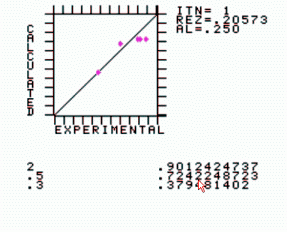The programs for download here were re-written by using the classic99 emulator.
Recently we had a 35 year aniversary of the high school graduation( http://ler73cj. wordpress. com ). I recalled my TI 99 and so I began this page of memories.
- In 1985 I aquired my TI for 100 US dollars (3 salaries) and I used it for scientific purposes (XB had 8 byte real number and subroutines like FORTRAN).
- Later, since 87 I used it in class room demos with 2 TVs attached (the 32 characters per line made the display legible).
- In 86/87 I used it to fit gamma disintegration curves from the Chernobyl fallout.

Adaptation in Europe was solved with some effort, i.e. replacing the modulator with a local one and using a tape recorder instead of cassette recorder (which was too expensive).
Below is the export licence of my unit.
Back in the '80, when I was young and ambitious, I learned from IMSL -revision 77 which came with a CDC mainframe. Most of it is now in SLATEC. Back then I used my TI-99/4A to implement numerical methods. Those days experimentors preferred the HP98300 series - another desktop omputer - for reasons of peripherals and less for volume and speed.
Interactivity was the keyword. The HP 9830 had half the speed of my TI but lot of peripherals. At last Windows won the competition ....
Actually at that time CDC's IMSL was somewhat a small SLATEC.
IMSL and SLATEC bear the fingerprint of Jack Dongarra's style and may be regarded as a programming school (in FORTRAN or whatever- say TI XB which is close as precision and has subroutines called by formal argument ).
Seymour Cray was also a nice person, RIP. CDC and IMSL are connected to Cray's personlity, who founded CDC. He also invented the dual processor arhitecture for CDCs.
Tutorial codes
I have transferred some sci subs (prepared before '90 - comments still in Romanian, I have to translate them in English one day):
- The one which costs me a lot of pain, plots the graph of a function. Code I have re-typed is here: TIfiles format <> Text format

- Another -solid- version of graph: TIfiles format <> Text format

- Nonlinear system - numerical derivatives used, so you don't have to
make mistakes when deriving
- No subs but gosub used:TIfiles format <> Text format
-XBasic, 2 subs: TIfiles format <> Text format
- Gradient method for least squares nonlinear models, again numerical
derivatives computed (the program is said "derivative free")
TIfiles format <> Text format

- Spectra fitting by using the Gauss Newton algorithm with a Levenberg-Marquart parameter. The mother of all fitting programs. The code description is here and dates back before 1978 ( D.P. Lazar, M. Morariu, raport extern IFA, SR-17-1976), i.e. much before the Press et al's "Numerical recipes". For the case test given, this program has convergence superior to the netlib's minpack. The learning example here simulates a spectrum with random erors of variable weight. By fitting the original parameters and the associated errors are retrived. No graphics : TIfiles format <> Text format
True experiment, TI-99/4A graphics (heavy work): TIfiles format <> Text format

- Eigenvalues and eigenvectors of a symmetric matrix: application to
Hueckel method for butadiene ( a computational chemistry example):
TIfiles format <> Text format
Theory you may find plenty on the internet; my e-book-(still in Romanian) is at:


